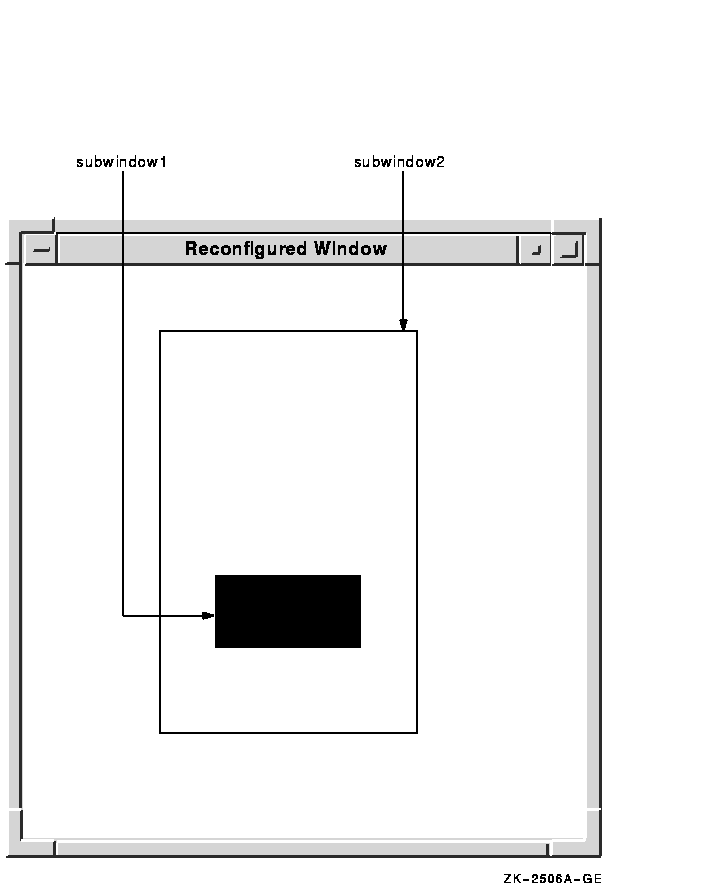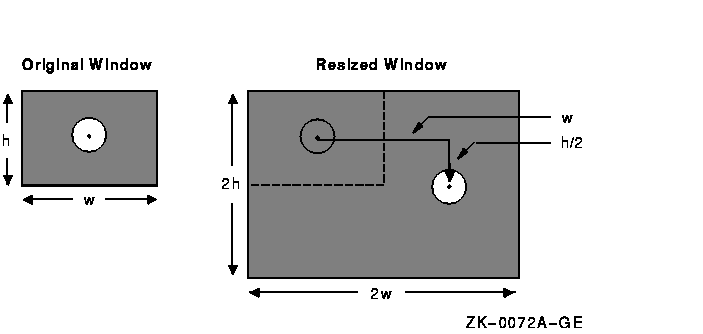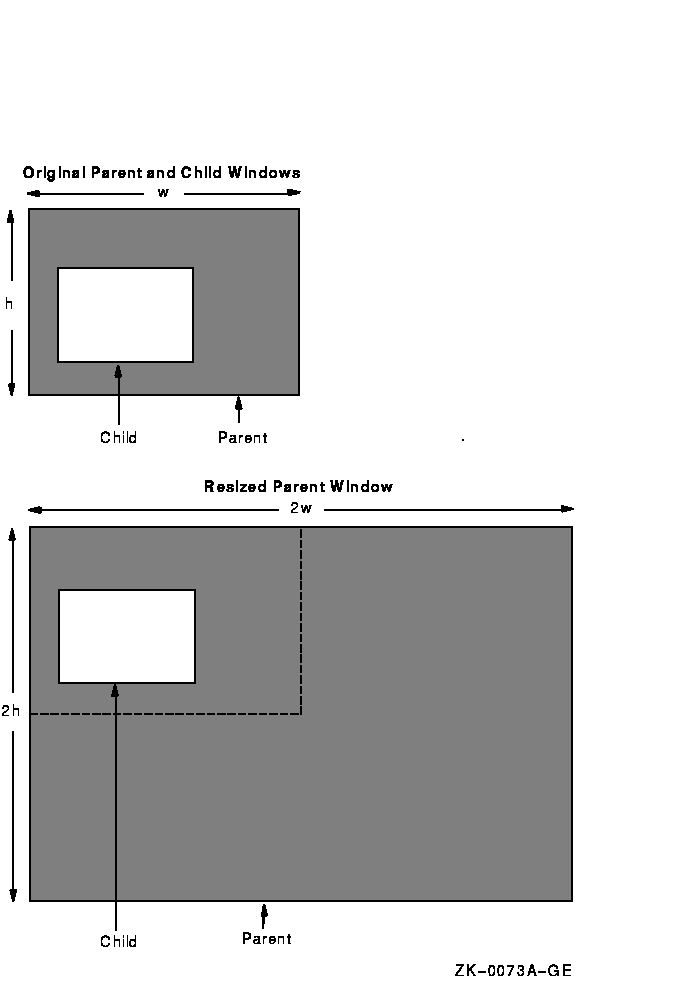 |
VMS DECwindows Guide to Xlib (Release 4)
Programming: MIT C Binding
- When the user clicks MB1 in subwindow
subwin1, the client calls the CHANGE PROPERTY routine. CHANGE
PROPERTY causes the server to change the property identified by the
atom atom_id to the value specified by property_data.
The property is associated with the parent window, win.
When changing properties, clients can specify how the server should
treat the property. If the client specifies the constant
PropModeReplace, the server discards the previous
property. If the client specifies the constant
PropModePrepend, the server inserts the new data at
the beginning of the existing property data. If the client specifies
the constant PropModeAppend, the server inserts the
new data at the end of the existing property data.
Changing the
property causes the server to send a property notify event to
win. For information about event handling, see Chapter 9.
- After checking to ensure that the changed
property is the one to obtain, the client calls the GET WINDOW PROPERTY
routine.
- After getting the string data from the parent
window, the client uses it to write text in subwin2. For
information about writing text, see Chapter 8.
In addition to the GET WINDOW PROPERTY routine, Xlib includes the
property-management routines described in Table 3-5.
Table 3-5 Routines for Managing Properties
| Routine |
Description |
|
LIST PROPERTIES
|
Returns a list of properties defined for a specified window.
|
|
ROTATE WINDOW PROPERTIES
|
Rotates the properties of a specified window and generates a property
notify event. For more information about property notify events, see
Chapter 9.
|
|
DELETE PROPERTY
|
Deletes a specified property.
|
3.6 Exchanging Properties Between Clients
Xlib provides routines that enable clients to exchange properties. The
properties, which are global to the server, are called
selections. Text cut from one window and pasted into
another window exemplifies the global exchange of properties. The text
cut in window A is a property owned by client A. Ownership of the
property transfers to client B, who then pastes the text into window B.
Properties are exchanged between clients by a series of calls to
routines that manage the selected text. When a user drags the pointer
cursor, client A responds by calling the SET SELECTION OWNER routine.
SET SELECTION OWNER identifies client A as the owner of the selected
text. The routine also identifies the window of the selection,
associates an atom with the text, and puts a time-stamp on the
selection. The atom, XA_PRIMARY, names the selection. The time-stamp
enables any clients competing for the selection to determine selection
ownership.
Clients can determine the owner of a selection by calling the GET
SELECTION OWNER routine. This routine returns the identifier of the
window that currently owns the specified selection.
By calling the CONVERT SELECTION routine, clients ask the owner of a
selection to convert it to a particular data type. If conversion is
possible, the client converting the selection notifies
the client requesting the conversion that the selection is available.
The property is then exchanged.
For example, when a user decides to paste the selected text in window
B, client B, who owns window B, sends client A a selection request. The
request identifies the window requesting the cut text and the format in
which the client would like the property transferred.
In response to the request, client A first checks to ensure that the
time of the request corresponds to the time in which client A owns the
selection. If the time coincides and if client A can convert the
selection to the data type requested by client B, client A notifies
client B that the text is stored and available. Client B then retrieves
the data by calling the GET WINDOW PROPERTY routine.
Clients request and notify other clients of selections by using events.
For information about using events to request, convert, and notify
clients of selections, see Chapter 9. For style guidelines about
using selections, see the OSF/Motif Style Guide.
3.7 Changing Window Characteristics
Xlib provides routines that enable clients to change window position,
size, border width, stacking order, and attributes.
This section describes how to use Xlib routines to do the following:
- Change multiple window characteristics in one call
- Change position, size, or border width
- Change stacking order
- Change window attributes
3.7.1 Reconfiguring Windows
Xlib enables clients either to change window characteristics using one
call or to use individual routines to reposition, resize, or change
border width.
The CONFIGURE WINDOW routine enables clients to change window position,
size, border width, and place in the hierarchy. To change these window
characteristics in one call, use the CONFIGURE WINDOW routine, as
follows:
- Set values of relevant members of a window changes data structure.
- Indicate what is to be reconfigured by specifying the appropriate
flag in the CONFIGURE WINDOW value_mask argument.
The window changes data structure enables clients to specify one or
more values for reconfiguring a window. The following illustrates the
window changes data structure:
typedef struct {
int x, y;
int width, height;
int border_width;
Window sibling;
int stack_mode;
} XWindowChanges;
|
Table 3-6 describes the members of the data structure.
Table 3-6 Window Changes Data Structure Members
| Member Name |
Contents |
|
x
|
Defines, with the y member, the new location of the window relative to
the origin of its parent.
|
|
y
|
Defines, with the x member, the new location of the window relative to
the origin of its parent.
|
|
width
|
Defines the new width of the window, excluding the border.
|
|
height
|
Defines the new height of the window, excluding the border.
|
|
border_width
|
Specifies the new window border in pixels.
|
|
sibling
|
Specifies the sibling window for stacking order.
|
|
stack_mode
|
Defines how the window is restacked. Table 3-7 lists constants and
definitions for restacking windows.
|
The client can change the hierarchical position of a window in relation
to all windows in the stack or to a specified sibling. If the client
changes the size, position, and stacking order of the window by calling
CONFIGURE WINDOW, the server restacks the window based on its final,
not initial, size and position. Table 3-7 lists constants and
definitions for restacking windows.
Table 3-7 Stacking Values
| Constants |
Relative to All Windows |
Relative to Siblings |
|
Above
|
Top of stack.
|
Just above the sibling.
|
|
Below
|
Bottom of stack.
|
Just below the sibling.
|
|
TopIf
|
If any sibling obscures a window, the server places the obscured window
on top of the stack.
|
If the specified sibling obscures a window, the server places the
obscured window at the top of the stack.
|
|
BottomIf
|
If a window obscures any sibling, the server places the obscuring
window at the bottom of the stack.
|
If a window obscures the specified sibling, the server places the
obscuring window at the bottom of the stack.
|
|
Opposite
|
If any sibling obscures a window, the server places the obscured window
on top of the stack. If a window obscures any window, the server places
the obscuring window at the bottom of the stack.
|
If the specified sibling obscures a window, the server places the
obscuring window on top of the stack. If a window obscures the
specified sibling, the server places the obscuring window on the bottom
of the stack.
|
Xlib assigns a symbol to the flag associated with each member of the
data structure (Table 3-8).
Example 3-5 illustrates using CONFIGURE WINDOW to change the position,
size, and stacking order of a window when the user presses a button.
| Example 3-5 Reconfiguring a Window Using the
CONFIGURE WINDOW Routine |
/* This program changes the position, size, and stacking
order of subwindow1 */
static void doButtonPress(eventP)
XEvent *eventP
{
XWindowChanges xwc;
(1) xwc.x = 200;
xwc.y = 350;
xwc.width = 200;
xwc.height = 50;
xwc.sibling = subwindow2;
xwc.stack_mode = Above;
(2) XConfigureWindow(dpy, subwindow1, CWX | CWY | CWWidth | CWHeight | CWSibling
| CWStackMode, &xwc);
}
|
- Assign values to relevant members of the
window changes data structure. Because the client identifies a sibling
(subwindow1), it must also choose a mode for stacking
operations.
- The call to reconfigure subwindow1.
The CONFIGURE WINDOW routine call has the following format:
XConfigureWindow(display, window_id, change_mask, values)
|
Create a mask by performing a bitwise OR operation on relevant
flags that indicate which members of WINDOW CHANGES the client has
defined.
Figure 3-7 illustrates how the windows look after being reconfigured.
Figure 3-7 Reconfigured Window

Table 3-9 lists routines to change individual window
characteristics.
Table 3-9 Window Configuration Routines
| Routine |
Description |
|
MOVE WINDOW
|
Moves a window without changing
its size.
|
|
RESIZE WINDOW
|
Changes the size of a window without moving it. The upper left window
coordinate does not change after
resizing.
|
|
MOVE RESIZE WINDOW
|
Moves and changes the size of a
window.
|
|
SET WINDOW BORDER WIDTH
|
Changes the border width of a
window.
|
3.7.2 Effects of Reconfiguring Windows
It is important to know how reconfiguring windows affects graphics and
text drawn in them by the client. (See Chapter 6 for a description
of working with graphics and Chapter 8 for a description of writing
text.) When a client resizes a window, window contents are either moved
or lost, depending on the bit gravity of the window.
Bit gravity indicates that a designated region of the
window should be relocated when the window is resized. Resizing also
causes the server to resize children of the changed window.
To control how the server moves children when a parent is resized, set
the window gravity attribute. Table 3-10 lists
choices for retaining window contents and controlling how the server
relocates children.
Table 3-10 Gravity Definitions
| Constant Name |
Movement of Window Contents and Subwindows |
|
ForgetGravity
|
The server always discards window contents and tiles the window with
its selected background. If the client has not specified a background,
existing screen contents remain the same.
|
|
NorthWestGravity
|
Not moved.
|
|
NorthGravity
|
Moved to the right half of the window width.
|
|
NorthEastGravity
|
Moved to the right, the distance of the window width.
|
|
WestGravity
|
Moved down half the window height.
|
|
CenterGravity
|
Moved to the right half of the window width and down half of the window
height.
|
|
EastGravity
|
Moved to the right, the distance of the window width and down half the
window height.
|
|
SouthWestGravity
|
Moved down the distance of the window height.
|
|
SouthGravity
|
Moved to the right half of the window width and down the distance of
the window height.
|
|
SouthEastGravity
|
Moved to the right, the distance of the window width and down the
distance of the window height.
|
|
StaticGravity
|
Contents or origin not moved relative to the origin of the root window.
Static gravity only takes effect with a change in window width and
height.
|
|
UnmapGravity
|
Window should not be moved; the child should be unmapped when the
parent is resized.
|
The client can change the hierarchical position of a window in relation
to either all windows in the stack or to a specified sibling. If the
client changes the size, position, and stacking order of the window by
calling CONFIGURE WINDOW, the server restacks the window based on its
final, not initial, size and position. Table 3-7 lists constants and
definitions for restacking windows.
Figure 3-8 illustrates how the server moves the contents of a
reconfigured window when the bit gravity is set to the constant
EastGravity.
Figure 3-9 illustrates how the server moves a child window if its
parent is resized and its window gravity is set to the constant
NorthwestGravity.
Figure 3-8 East Bit Gravity

Figure 3-9 Northwest Window Gravity

3.7.3 Changing Stacking Order
Xlib provides routines that alter the window stacking order in the
following ways:
- A specified window moves to either the top or the bottom of the
stack.
- The lowest mapped child obscured by a sibling moves to the top of
the stack.
- The highest mapped child that obscures a sibling moves to the
bottom of the stack.
Use the RAISE WINDOW
and LOWER WINDOW
routines to move a specified window to either the top or the bottom of
the stack, respectively.
To raise the lowest mapped child of an obscured window to the top of
the stack, call CIRCULATE SUBWINDOWS UP.
To lower the highest mapped child that obscures another child, call
CIRCULATE SUBWINDOWS DOWN.
The CIRCULATE SUBWINDOWS routine enables the client to perform these
operations by specifying either the constant
RaiseLowest or the constant
LowerHighest.
To change the order of the window stack, use RESTACK WINDOW,
which changes the window stack to a specified order. Reordered windows
must have a common parent. If the first window the client specifies has
other unspecified siblings, its order relative to those siblings
remains unchanged.
3.7.4 Changing Window Attributes
Xlib provides routines that enable clients to change the following:
- Default contents of an input-output window
- Border of an input-output window
- Treatment of the window when it or its relative is obscured
- Treatment of the window when it or its relative is moved
- Information the window receives about operations associated with
other windows
- Color
- Cursor
Section 3.2.2 includes descriptions of window attributes and their
relationship to the set window attributes data structure.
This section describes how to change any attribute using the CHANGE
WINDOW ATTRIBUTES routine. In addition to CHANGE WINDOW ATTRIBUTES,
Xlib includes routines that enable clients to change background and
border attributes. Table 3-11 lists these routines and their
functions.
Table 3-11 Routines for Changing Window Attributes
| Routine |
Description |
|
SET WINDOW BACKGROUND
|
Sets the background pixel
|
|
SET WINDOW BACKGROUND PIXMAP
|
Sets the background pixmap
|
|
SET WINDOW BORDER
|
Sets the window border to a specified pixel
|
|
SET WINDOW BORDER PIXMAP
|
Sets the window border to a specified pixmap
|
To change any window attribute, use CHANGE WINDOW ATTRIBUTES as follows:
- Assign a value to the relevant member of a set window attributes
data structure.
- Indicate the attribute to change by specifying the appropriate flag
in the CHANGE WINDOW ATTRIBUTES value_mask argument.
To define more than one attribute, indicate the attributes by doing a
bitwise OR on the appropriate flags.
See Table 3-3 for symbols Xlib assigns to each member to facilitate
referring to the attributes.
Example 3-6 illustrates using CHANGE WINDOW ATTRIBUTES to redefine
the characteristics of a window.
| Example 3-6 Changing Window Attributes |
XSetWindowAttributes xswa;
(1) xswa.background_pixel = BlackPixelOfScreen(dpy);
xswa.border_pixel = WhitePixelOfScreen(dpy);
(2) XChangeWindowAttributes(dpy, win, CWBorderPixel | CWBackPixel, &xswa);
.
.
.
|
- Assign new values to a set window attributes
data structure.
- Call CHANGE WINDOW ATTRIBUTES to change the
window attributes. The CHANGE WINDOWS ATTRIBUTES routine has the
following format:
XChangeWindowAttributes(display, window_id, attributes_mask,
attributes)
|
Specify the attributes to change with a bitwise inclusive OR of the
relevant symbols listed in Table 3-3. The values
argument passes the address of a set window attributes data structure.
3.8 Getting Information About Windows
Using Xlib information routines, clients can get information about the
parent, children, and number of children in a window tree; window
geometry; the root window in which the pointer is currently visible;
and window attributes.
Table 3-12 lists and describes Xlib routines that return information
about windows.
Table 3-12 Window Information Routines
| Routine |
Description |
|
QUERY TREE
|
Returns information about the window tree
|
|
GET GEOMETRY
|
Returns information about the root window identifier,
coordinates, width and height, border width, and depth
|
|
QUERY POINTER
|
Returns the root window that the pointer is currently on
and the pointer coordinates relative to the root window origin
|
|
GET WINDOW ATTRIBUTES
|
Returns information from the window attributes data structure
|
To get information about window attributes, use the GET WINDOW
ATTRIBUTES routine. The client receives requested information in the
window attributes data structure. See the X Window System for more
information about the window attributes data structure.
|


